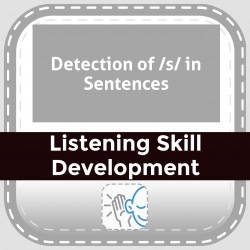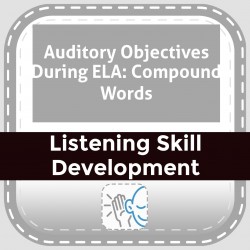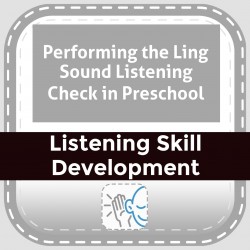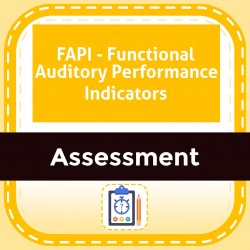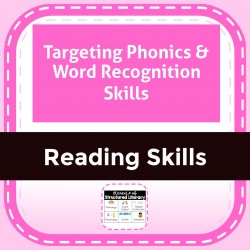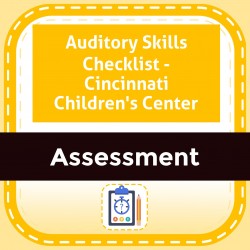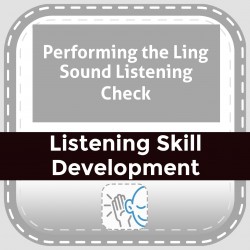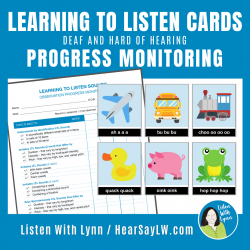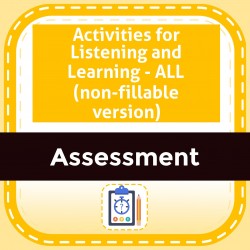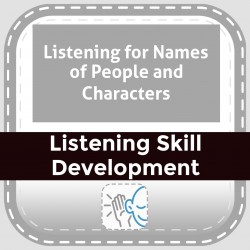Ability Levels
Categories
Resource Types
Age/Grade Range
CCSS
Anchor Standard
Speaking & Listening
Language
Reading
Detection of /s/ in Sentences
$ 195
Strategies and activities for detecting /s/ in words within sentences. Includes a fillable sheet and scripts for activities.
Auditory Objectives During ELA: Compound Words
$ 295
Describes auditory components of compound words.Data collection sheet and materials for discrimination of auditory discrimination between compound and non compound 2-syllable words. Go Fish game to ma
...
tch 20 compound word cards and definition cards. Suggestions for differentiation. Activities conducted through listening, without print.
Performing the Ling Sound Listening Check in Preschool
$ 195
This handout describes how to perform the Ling sound listening check in the preschool or early childhood classroom setting.
FAPI - Functional Auditory Performance Indicators
$ 0
FAPI - Functional Auditory Performance Indicators: An Integrated Approach to Auditory Skill Development. The FAPI assesses the functional auditory skills of children with hearing loss. It can be used
...
by parents, therapists, early interventionists, and teachers. The profile lists auditory skills in an integrated hierarchical order with seven categories. Word version
Targeting Phonics & Word Recognition Skills
$ 195
Support development of foundational reading skills with activities and materials to practice: 1) vowel perception in isolation and in words, phoneme blending and sound-letter association; 2) discrimin
...
ation of vowels in words, sorting long & short vowels.
Auditory Skills Checklist - Cincinnati Children's Center
$ 0
The Auditory Skills Checklist is an evaluation tool designed to assess and track a child's auditory capabilities over time. The ASC is a 35-item checklist used by the managing audiologist or therapist
...
, which relies on observation by the family and/or therapist.
Performing the Ling Sound Listening Check
$ 495
Detailed description and strategies for why, when, how, who hearing aids should be monitored for infants and toddlers with hearing loss.
Learning To Listen Cards and Progress Monitoring Tool
$ 5
This resource includes a printable set of 30 Learning to Listen* Cards, an Observation Progress Monitoring Tool, and Tips For parents and professionals teaching the Learning To Listen Sounds and Phras
...
rases to a young child who is deaf or hard of hearing utilizing hearing technology such as cochlear implants or hearing aids with the goal of learning to listen and talk. INCLUDES:High-resolution Learning To Listen cards for quality printingObservation Progress Monitoring Tool10 Tips For teaching the Learning To Listen Sounds and PhrasesListening to Listen Sounds - Actions and AdjectivesLearning to Listen Sound - Object AssociationsLearning to Listen Sounds are associated with toys and objects that are commonly part of a baby or young child’s daily routines and activities. Individual families may use a variety of different Learning to Listen sounds, words and phrases depending on their lifestyle and culture. These onomatopoeic sounds contain acoustic properties that are significant in the perception of speech. The Learning to Listen Sounds are easy to hear for most babies wearing hearing technology.Skilled interventionists coach parents and caregivers about auditory skill development while presenting the Learning to Listen toys or activities. Observation data can be collected about the child’s auditory access to aspects of speech like duration, intensity, pitch, and voicing as well as vowel and consonant perception by contrasting toys in strategically chosen groups. This information is critical for optimally setting hearing aids and programming cochlear implants.*Adapted from Simser, 2002, Estabrooks, 2006, Estabrooks & Birkenshaw-Fleming, 1994.
Activities for Listening and Learning - ALL (non-fillable version)
$ 0
ALL - Performance Checklist for Development of Complex Listening Skills. Provides a list of Listening, Communication, and Learning Skills with spaces to complete progress. Areas: auditory association,
...
discrimination, memory, closure, humor, etc. Fillable version also available.
Listening for Names of People and Characters
$ 195
Prompts (excerpts from classic children's stories and school-based role play scenarios) to practice identifying spoken names in sentences and discourse. Includes information for teacher about why lear
...
ning and remembering names can be challenging for DHH students, sample data collection table and suggestions for extension activities.
 Your browser is out of date. For best experience switch to latest updated Browser.
Your browser is out of date. For best experience switch to latest updated Browser.
 Get Chrome
Get Chrome Get Edge
Get Edge Get Firefox
Get Firefox